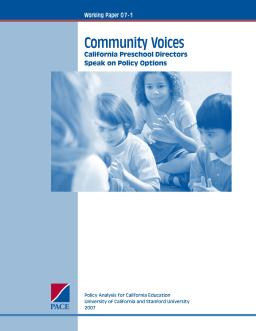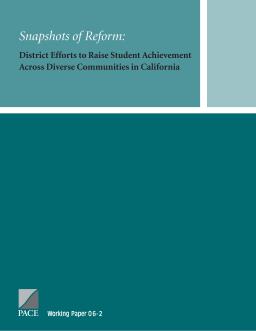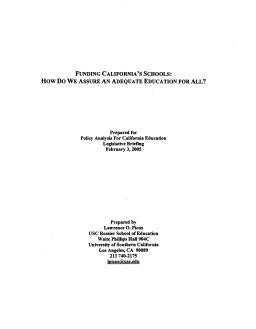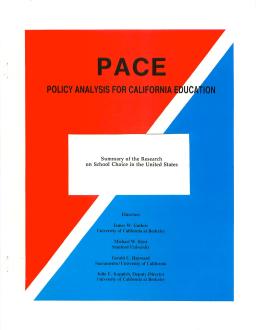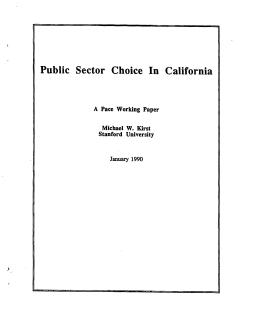Investing in Education Facilities and Stronger Communities
Published
Summary
California is midway through one of the grandest public infrastructure projects ever attempted. Over the coming decade school officials will complete an $82 billion effort, building new schools and renovating old facilities, supported by taxpayers and private investors. But are state officials and local planners building schools mindfully to advance educational quality and lift local communities?
California Preschool Directors Speak on Policy Options
Published
Summary
This working paper discusses the potential of integrating academic and occupational content through Career-Technical Education (CTE)/multiple pathways to improve California's high schools. The approach can enhance student motivation and engagement in school, improve employment and earnings after graduation, and provide more opportunities for students. Authors suggest building on existing practices in career academies, restructured high schools, and community colleges, but note that additional funding, technical assistance, and professional development will be necessary to support this approach...
District Efforts to Raise Achievement across Diverse Communities in California
Published
Summary
This paper examines the effectiveness of California's class-size reduction policy in elementary schools, finding that it improved student achievement in reading and math, particularly for low-income and minority students. However, it also concludes that the policy was expensive and had other trade-offs, such as limiting teacher collaboration and reducing funding for other important educational programs. The report suggests that policymakers consider more cost-effective and comprehensive approaches to improving student outcomes.
The Reliability of How States Track Achievement
Published
Summary
This working paper analyzes the impact of the No Child Left Behind Act on the state's funding system and notes that it exacerbated inequities by penalizing schools that did not meet annual progress targets without providing sufficient resources to help them improve. The authors suggest that a more equitable funding system based on student needs and costs would better serve all students, including those who are struggling to meet academic standards.
Ideals, Evidence, and Policy Options
Published
Summary
Many California children benefit from preschooling, but enrollment rates are lower for poor and working-class families. Quality is uneven, and policy makers must address key questions regarding expanding and improving preschooling, including who should benefit and who should pay, who should operate it, how to improve quality, and how to structure it for diverse families. Evidence can inform policy options, which stem from differing ideals about preschooling. Nationwide evidence is considered in this review.
How Do We Assure an Adequate Education for All?
Published
Summary
California ranks 44th in the nation in education spending, spending only 86.1% of the national average per pupil in 2001-02. The recession of the early 2000s resulted in dramatic budget deficits for the state and substantial reductions to the expected level of school funding. Research suggests using the concept of adequacy to estimate the costs of providing an educational program that will enable all—or almost all—children to meet the state's high proficiency standards and offers recommendations for finding additional resources needed to adequately fund California's schools.
Which Families to Serve First? Who Will Respond?
Published
Summary
This paper discusses extending access to preschool for families in California, focusing on targeting priorities to yield strong enrollment demand and discernible effects on young children's early development and school readiness. It analyzes different targeting mechanisms and suggests experimenting with alternative expansion strategies, rather than investing exclusively in one method. The report also describes which communities would benefit most and considers the criteria for judging the wisdom of targeting options.
Assessing Balance and Substance
Published
Summary
Arnold Schwarzenegger received lopsided media attention during the first weeks of his campaign, according to a UC study. 87% of the 164 stories reported by the New York Times focused on Schwarzenegger. Less coverage was given to Bustamante, who was out-polling the actor at the time. The study found little coverage of policy issues and that Schwarzenegger’s personal history and character received more attention. Lesser-known candidates, including Peter Camejo and Arianna Huffington, received proportionally less coverage.
Published
Summary
The paper provides a synthesis of existing literature on school choice, with a focus on research that informs public policy development and evaluation. It presents information without taking a position for or against school choice and is intended for policymakers, parents, educators, and the public. The paper covers six sections, including types of school choice programs, efficacy, economic theories, private schools, public opinion, and unresolved research questions.
A PACE Working Paper
Published
Summary
California saw renewed interest in the issue of education choice in the late 1980s, with 11 bills introduced in the 1989 legislative session. The primary reason for this is the reluctance to consider public aid to private schools. California State Superintendent Bill Honig proposed AB 2134, which would require parents to choose a public school each year. The politics of choice have changed, and low-cost proposals that don't promote alternative school sites have become popular. This paper analyzes the California bills and their implications for education choice in California.

